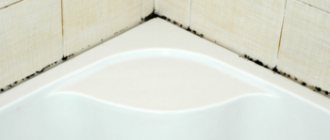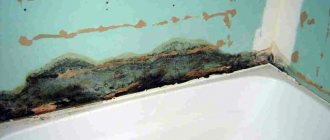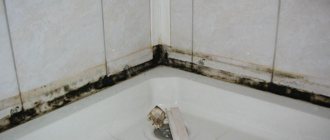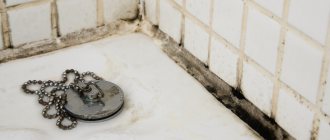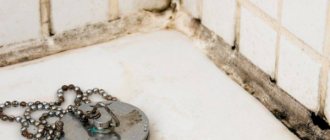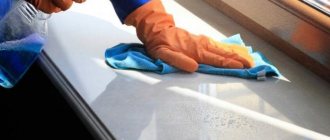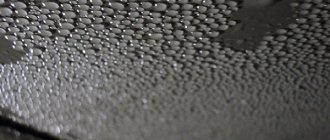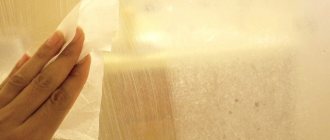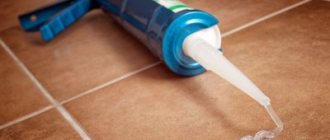Quite often you have to deal with such an unpleasant phenomenon as black spots on the ceiling in the bathroom - it's mold. In addition to spoiling the appearance of the room, mold is harmful to human health.
Its waste products are toxic and after inhalation, a person may develop allergic reactions and feel worse. Although it is difficult to fight mold, it must be done and it is possible to cope with it.
Dangers of each type
There are always mold spores in the air, but they begin to develop only under favorable conditions. It can appear on concrete, brick and other surfaces and be black, green or blue.
Types of mold:
- black mold , its type depends on the stage of development;
- white mold on walls is rare, it is often confused with efflorescence, but if you pick it up in your hands, it will knead and the efflorescence will crumble;
- blue , it affects wooden surfaces;
- actinomycetes are a cross between algae and fungi; they also infect wooden objects;
If we talk about a person’s reaction to mold, it can be divided into the following groups:
- Allergic , it is especially dangerous for people with diseases of the respiratory system and is often the cause of allergic rhinitis.
- Pathogenic , it can cause various diseases, healthy people with strong immunity usually cope with it, but children, the elderly and people with weak immunity can develop diseases such as pneumonia, bronchitis, etc. It forms gray and black colonies.
- Toxic species can cause serious complications, and even death. Problems caused by such mold can be in the form of irritation, other symptoms and even lead to the development of cancer.
Mold spores can enter the human body through the air, during breathing, through the skin or through food.
The most common diseases that arise from exposure to mold are asthma, pneumonia, other respiratory diseases, upset stomach, various skin rashes, and headaches.
With prolonged exposure to pathogenic species, a person may develop internal bleeding, kidney, liver, and lung diseases. When mold enters the human body, it is called mycosis; for diagnosis, it is necessary to contact a specialized laboratory.
How to get rid of black and pink mold in the bathroom
One of the most common types of fungi is pink fungus. Being on the surface of household objects, it does not pose any particular danger, but in no case should it be consumed as food if it has settled on food. Despite the name, the color can vary from some shades of pink to almost orange.
This kind of mold is a big “lover” of darkness and moisture, so it lives in the seams between tiles, in shower stalls, under the bathtub and washbasin, and survives on the remnants of soap products. Despite its apparent harmlessness, do not forget that such mold can cause diseases of the respiratory and urinary tract.
It is quite easy to remove; using any specially designed detergent and subsequent treatment with a biocide is enough. In this case, you will avoid a minimal residue of bacteria, due to which their reproduction may resume.
Causes of mold
For mold to begin to grow in the bathroom, the following conditions must exist:
- presence of spores in the air;
- presence of a nutrient medium;
- favorable climate: high humidity, temperature more than 15 degrees, poor ventilation, uneven heating and freezing of walls.
Since we cannot influence the appearance of spores in the air and the presence of a breeding ground for mold, it turns out that the most effective way to combat it is to create effective ventilation and a constant temperature in the room.
The main causes of mold in the bathroom:
- poor ventilation, if it is not possible to install an effective exhaust hood in the bathroom ceiling, you need to ventilate the bathroom more often;
- the presence of moisture due to problems with water supply and sewerage;
- with poor waterproofing, moisture can enter the house through the foundation;
- heat loss in the corners of the room due to poor wall insulation;
- freezing of walls;
- improper operation of the drainage system.
Household chemicals: comparison table
Today, in construction hypermarkets and hardware stores you can find specialized substances designed to combat fungus. Many of them not only effectively remove black and pink spots, but also prevent their reappearance.
We have collected the best ones in a table. You can view their properties and get acquainted with approximate prices. For ease of use of data, you can use the horizontal scroll bar, as well as the ⇐ and ⇒ buttons on the keyboard.
| Name/average price | Peculiarities | Flaws |
| White/60 rub. |
|
|
| PRO-Brite Veksa (Pro-Brite Veksa)/80 rub. |
|
|
| Stop-Mold/100 rub. |
|
|
| Dali (Dali)/160 rub. |
|
|
| Fungi Clean (Fungi Klin)/220 rub. |
|
|
| Quelud Anti-mold (Quaelid) 370 rub. |
|
|
| Xiolate/380 rub. |
|
|
Elimination of causes
Before you start fighting mold, you first need to eliminate the reasons that led to its development.
If this is not done, then no modern or folk remedies will help you get rid of the fungus, since after a while it will appear again. Eliminating the causes of the fungus consists of the following steps:
- It is necessary to get rid of the source of constant humidity , that is, it is necessary to repair the sewerage and water supply systems if they have leaks.
- Creation of a normal ventilation system in the room . To do this, you need to check the ventilation duct, which may be closed, so it needs to be cleaned. One way to ventilate a bathroom is to install a breather, a compact supply ventilation system that is mounted on the wall and provides the room with fresh air. If the room has a plastic window, it is recommended to install ventilation ducts in it.
- to maintain a constant temperature in the bathroom to avoid large temperature changes. To do this, it is necessary to carry out high-quality insulation of the walls, install a heated towel rail, and install a heated floor under the tiles.
Some people believe that air conditioning will help get rid of mold, but this is not true, it helps reduce the humidity and temperature in the room, but does not supply fresh air, so it only drives mold spores around the room. There must be an effective ventilation system that will change the air in the room.
Further prevention
Mold is dangerous to the health of people and animals. Favorable environment for its appearance: humidity and warmth. Harmful fungi usually appear at temperatures above +25 and at high humidity above 90%.
Advice! When destroying mold, you need to wear special protective equipment, gloves and a mask, so as not to touch or inhale harmful spores.
A few tips to help prevent fungus from recurring:
The room must be ventilated regularly.- The room should not freeze.
- Drying things in a closed room is not recommended.
- Repair pipes promptly if leaks occur.
- Make a ventilation system.
- For cladding, use only moisture-resistant materials that contain an antifungal agent.
Removing mold
To remove mold from the bathroom ceiling, you can use both store-bought and folk remedies, but before using them, the surface must first be treated. Remove the top layer and dry everything well using a hair dryer; the air in the room should be dry.
Among the folk remedies, the most often used are:
- copper sulfate (10% solution), this is an effective method, but keep in mind that this substance is toxic, so it is necessary to work with gloves and a respirator, the composition is applied with a brush for several hours, after which it is washed off;
- bleach solution , it is also made at 10%, applied with a brush or sponge, but there is no need to rinse the surface, the presence of bleach will not allow the fungus to develop again, after using it, the room must be well ventilated;
- a solution of soda and vinegar is also an effective remedy; after using it, the ceiling surface must be washed with warm water and soap;
- a solution of 2 teaspoons of tea tree oil and 2 glasses of water, it is applied using a spray bottle and does not need to be washed off;
- a solution consisting of hydrogen peroxide, water, boric acid and vinegar , which are mixed in a ratio of 2:4:1:2 and wipe the affected surfaces with this composition.
There is another effective way - air ionization. In this case, a special device is used, it supplies air saturated with ions and microelements, which help get rid of mold and insects, it also makes the air in the room clean and healthy.
If we talk about purchased products, there are a lot of them, they can be either universal or intended for a specific type of fungus. The most popular and effective means are the following:
- “Atlas Mykos” effectively helps to get rid of mold, fungus and moss, diluted with water in a ratio of 1:2;
- "Teflex Anti-Mold Express" is used for processing wood, concrete, brick, plastic;
- “SZAVO” can be used effectively in places with high humidity; after drying, it does not leave any marks on the surface;
- “Belinka” is a simple and effective product, it can be used not only indoors, but also outdoors;
- besides this, there are many other products, for example “Spectrum Fungicide”, “Antialga B25”, “Mellerud”, “Well Done”, “Snežka Impregnation”, “Boramon C30”, “Titan Fungicide”, “Boramon”, etc. .
How to remove fungus under a suspended ceiling with your own hands?
The main reason for the occurrence of fungus under a suspended ceiling covering is poor ventilation of the room and the lack of a ventilation system:
- To get rid of a colony of fungi under a suspended ceiling, you must first dismantle the material. It is advisable to open the affected area as much as possible.
- Treat the ceiling with a solution of vinegar mixed with soda and water.
- Then apply antiseptic to the ceiling.
- Apply a primer to which an antifungal agent has been added. Dry. Replace the dismantled parts from the stretch ceiling.
Preventive actions
It is much easier to prevent mold from growing in the bathroom than to deal with it later. If you do not take preventive measures, then even after getting rid of mold, it will begin to appear again after a while. To prevent this from happening, it is recommended to adhere to the following rules:
- the room should have low humidity, so be sure to install a heated towel rail;
- ensure good ventilation, install a powerful fan, ventilate the bathroom;
- during repairs, be sure to treat the walls with antifungal agents;
- eliminate all leaks in the water supply and sewerage systems;
- do not dry clothes in the bathroom;
- Treat areas where water may get in with sealant.
Ceilings
0 votes
+
Vote for!
—
Vote against!
The problem of mold on the ceiling is quite relevant for many rooms, especially if they have high humidity. There are several methods to combat this unpleasant phenomenon. We will discuss their features, technology and how to remove mold from the ceiling below.
Table of contents:
- Mold on the ceiling: causes of formation
- How to remove mold from the ceiling: prevention and treatment
- Instructions on how to remove mold from the ceiling
- Methods for removing mold under a suspended ceiling
- Mold on the ceiling: how to get rid of it and prevent it
- How to treat a ceiling for mold: getting rid of mold in the bathroom
Mold on the ceiling: causes of formation
Ceiling mold is most common in bathrooms. This is due to constant dampness and high humidity in the room. To avoid this problem, you should organize a high-quality ventilation system in the room.
A damp environment and fungus cause black spots to appear on the surface of the ceiling, which are mold. Removing them will require a lot of effort, so before mold appears, it is better to prevent it.
The main causes of mold are:
- the presence of a damp environment, which is especially typical for the bathroom and kitchen, is the most common cause of mold on the ceiling;
- lack of normal ventilation in the room;
- sudden changes in temperature in the room, which leads to the formation of condensation;
- mold on the ceiling in an apartment appears due to flooding by neighbors, it is not necessary to flood your apartment, if there is a leak between the bathroom and the wall, moisture gradually gets onto your floor slab, thereby leading to the development of mold on the ceiling;
- the presence of fistulas and risers in floor slabs between floors, especially if they are made of non-galvanized steel;
- the presence of a cracked sewer joint in an apartment or with neighbors, the presence of a leak in cast iron sewer systems is not uncommon, so in some cases, it is because of them that mold appears on the ceiling.
Therefore, you should start getting rid of mold only after the cause of its appearance is known. For example, for rooms with excessive humidity, installing a powerful fan is sufficient.
If you do not fight mold, then in addition to the unpleasant appearance of the ceiling, it will also lead to health problems. First of all, the presence of mold in the house affects the lungs and leads to infectious diseases. In addition, the presence of fungus affects many of the body's systems, especially in children and people with weakened immune systems.
As they multiply, fungal spores spread to other areas of the house, the roof, walls, floor, and their presence leads to the gradual destruction of the entire home. Living in constant dampness for several years, the house can simply crumble into particles. Therefore, if there is the slightest suspicion of the development of fungus or mold, the fight against them should be started immediately.
How to remove mold from the ceiling: prevention and treatment
If there is no mold directly on the ceiling, however, if there are reasons for its appearance, a number of preventive measures should be taken to prevent the occurrence of this unpleasant process.
The first option for combating mold that has not yet appeared is copper sulfate. This product has an antibactericidal effect, but contains toxic substances. Adding it to lime will give it a slightly bluish tint. This solution is used to whitewash the ceiling in a room exposed to fungus.
Tip: If you plan to treat a previously painted ceiling with lime, you should not do this. Because the end result will be a surface with a lot of streaks and stains on it.
To eliminate black mold on the ceiling, use special antiseptic compounds in the form of primers. They are used during repairs, before applying finishing and after finishing work. The primer can not only destroy mold, but also prevent its occurrence. With the help of an antiseptic, it is even possible to penetrate concrete surfaces and prevent mold from appearing on them.
When choosing a particular primer composition, you should focus on the material from which the ceiling is constructed. There are many antiseptic compositions that are suitable for working on wooden, metal, plastered, and painted surfaces.
If you already have mold on the ceiling in your house or apartment, then you should take care of treatment.
Tip: Before starting work on removing mold from the ceiling, you should find out the cause of its occurrence and eliminate it. Otherwise, all measures to get rid of mold will be in vain and it will soon appear again.
First of all, the finishing is removed from the ceiling; if it was previously whitewashed with lime, then for this, an ordinary sponge moistened with water is used. At the same time, you should work for quite a long time, since lime-based whitewash is quite durable.
If a sufficiently thick layer of whitewash was applied to the concrete base, then it is best to use a spatula to remove it. The entire ceiling is first wetted with water, which will reduce the level of adhesion of the whitewash and the concrete base.
Another way to get rid of whitewash is to apply a solution containing water, soap and calcium-based soda to its surface. The soap should be grated into ten liters of water; you will need about five tablespoons of soda.
After cleaning the surface from whitewash, you should wait until the ceiling is completely dry. After this, it is coated with a primer with an antiseptic effect. Apply the primer in several layers, waiting for each of them to dry. The drying time of the primer is indicated in the manufacturer's instructions. In order to treat the seams between the plates, use a brush; it can fill the voids well.
After the antiseptic primer has dried, the process of applying a penetrating solution follows. In this case, it will be possible to increase the level of adhesion of concrete and plaster mortar.
Next, the ceiling is plastered; after the plaster has dried, putty should be applied. Each layer of finishing materials applied to the ceiling surface alternates with the ceiling being treated with a primer. After applying the putty, the surface should be sanded and treated with a primer. After this, the ceiling is painted.
Instructions on how to remove mold from the ceiling
If the previous mold removal option does not suit you, then use the instructions below for quickly removing mold.
In this case, you will need any detergent that contains chlorine-based substances. An excellent option would be to use the cheapest regular white. Prepare gloves for work, as this solution is quite aggressive. In addition, you should wear a protective mask and goggles to prevent the liquid from accidentally getting on the mucous membranes of your eyes and nose.
This liquid is first used to treat the affected areas of the ceiling, and after they dry, the entire ceiling.
Tip: If you treated the ceiling with copper sulfate and stains appeared on it, then treatment with chlorinated compounds will get rid of them and the ceiling will become perfectly white.
If the lesions are not too large, then using a soap solution with an alkaline composition will be sufficient. In this case, you should rub one laundry soap and fill it with two liters of warm water.
Another good remedy for ceiling mold is a solution of two tablespoons of tea tree oil and two glasses of water. Use a spray bottle to apply the solution.
Some experts recommend applying baking soda to the affected areas, followed by vinegar. To apply it also use a spray bottle. After a reaction has formed between these substances, they are removed from the ceiling with an abrasive brush.
Methods for removing mold under a suspended ceiling
Stretch ceilings are most often made on the basis of PVC film. These materials are synthetic and do not allow mold or mildew to form on them. However, if there is high humidity under the ceiling, mold will still attack it. Poorly performed installation, waterproofing and vapor barrier work on a stretch ceiling leads to mold appearing in the space between it and a regular ceiling. At the same time, getting rid of this problem is much more difficult than getting rid of mold on a regular ceiling.
If there is mold directly on the suspended ceiling itself, you can be sure that there is much more of it under the ceiling space. In such a situation, care should be taken to remove and retighten the entire structure. To perform this work, you should use the services of specialists, since it is quite difficult to install a suspended ceiling yourself.
To remove the ceiling, the baseboard is first removed. The film is gradually pulled back and the canvas is dismantled. Next, treat the affected areas with an antiseptic solution. This will help fight mold. After this, the stain is removed with a brush and the entire ceiling is washed with a damp cloth. If there are cracks in the ceiling, special attention should be paid to them and also treated with an antiseptic.
Next, the cracks are treated with a sealant that will help prevent mold from growing inside them. For prevention, the entire ceiling is treated with a primer that has an antifungal effect. At the final stage, the film is installed in place using special equipment. Then it is coated with a primer. In order to install the canvas without sagging, you should use a hair dryer during its installation.
Mold on the ceiling: how to get rid of it and prevent it
There are a huge number of ways to combat mold, but the easiest way is to prevent its occurrence. To prevent mold from appearing in your home, use these recommendations:
- ventilate the room regularly;
- provide a high-quality ventilation system in the house;
- do not leave wet laundry in the house, hang it outside, even in winter;
- ensure the tightness of all pipes through which water flows in the house;
- Make sure that the ventilation ducts in the bathroom are in good working order;
- When carrying out repairs, make sure that most materials are moisture resistant.
Please note that for mold and mildew to form, the room must have very high humidity, more than 80 percent and a temperature of about twenty degrees. Therefore, if the humidity is too high, it is imperative to ventilate the room.
How to treat a ceiling for mold: getting rid of mold in the bathroom
To remove mold from the ceiling, use the following materials:
- spatula, medium size;
- gloves;
- sprayer;
- stairs;
- floor coverings;
- means to combat mold.
Remove all furniture from the room if possible, lay a film or sheet on the floor. Pour water into a spray bottle and spray the ceiling with it. Next, you should use a spatula to remove the plaster on which there is fungus.
It is preferable if you remove the ceiling layer up to 10-15 cm, since fungal spores penetrate quite deep into the walls. Next, wait until the ceiling dries; for these purposes, use an antifungal agent. These drugs include substances in the form of:
- bleach;
- copper sulfate;
- bleaches;
- soda and vinegar;
- soap
It is preferable to choose a primer. It is applied to the base of the ceiling in two or three layers. Before applying the primer, read the instructions; however, some of the compositions require additional dilution with water.
When using copper sulfate, you should dilute it with water in a ratio of 50 grams of product per 5 liters of water. The surface is treated with a solution in several layers.
If you plan to use white, then it is diluted with water and applied several times. Please note that before applying the composition, the ceiling must be pre-moistened. After two hours after applying the white, it is washed off from the ceiling using ordinary water.
Mechanical method of removing fungus
Having discovered black spots in the room, the housewife usually takes a rag or a scraper, trying to wash off or scrape off the mold. To get an effective result, you need to know how to properly remove colonies of fungi in the bathroom.
First of all, detected areas of mold must be thoroughly moistened with water. This manipulation will prevent fungal spores from entering the air, which can cause new lesions.
Then you need to take a metal scraper or another similar tool (steel brush, drill with a grinding attachment), which will help thoroughly remove the affected area of the surface.
It is advisable to remove as much of the coating layer as possible (plaster, wallpaper, paint); For materials such as concrete and wood, milling is also possible.
In advanced cases, this method is not effective enough, since the mycelium can penetrate deeply even into inorganic surfaces, for example, hide under tiled cladding.
In this case, to solve the problem it will be necessary to carry out a major overhaul, including:
- removing walls from decorative coverings (ceramic tiles, wallpaper, layers of paint);
- removing lime or paint coating from the ceiling;
- replacement of floor finishing material.
When carrying out major repairs, it is imperative to treat all surfaces with fungus-killing agents.
Preparations (folk or professional) should be applied to an area larger in size than the area where the fungus is visible in order to remove micromycelium invisible to the naked eye.
The simplest method of combating mold is mechanical removal, but this method brings the desired result only at an early stage of the lesion.
Each surface must be treated at least 2-3 times, each time waiting until the previously applied fungicidal preparation has completely dried. When performing repairs, it is advisable to use building materials with antifungal additives.
Store-bought mold repellents
There are a lot of products in stores that remove mold on the ceiling in the bathroom and prevent its reappearance, therefore, the question of how to get rid of it is no longer worth asking for a long time after a one-time use.
They cost differently. There are expensive sprays, and there is ordinary copper sulfate. Both are equally effective, by and large.
The only difference is that copper sulfate leaves colored marks on the walls, while expensive products are colorless and often do not have a pungent odor. But, you understand, this does not make them any less harmful.
After treating the bathtub ceiling with this product, leave the doors open and ventilate for a couple of days. It is advisable not to stay in such a room for more than five minutes until the substance is completely gone.
The best mold remover
There is hardly any one best way to remove anything. Depending on the types of fungus and types of surface, they are completely different, especially when it comes to purchased specialized products.
Any bleach or detergent that contains antifungal components copes best with this task. But such cleaning is not suitable for all surfaces. Porous materials such as plastic must be handled especially carefully. For rooms with acrylic painting, it is worth finding a gentle product.
Chemical substances
In addition to solutions that you can make yourself, chemical agents are highly effective. They can be purchased in hardware departments of stores.
As a rule, containers with a chemical product have a volume of at least half a liter and a built-in sprayer.
This design of the bottle allows you to spray the product evenly, getting into hard-to-reach places.
Directions for use are indicated on the packaging of each cleaning product. Spraying is carried out evenly over the surface of the sealant. After allowing a certain amount of time for the reaction to occur, brushing is carried out.
Сillit Bang anti-stain
This liquid product is available in 750 ml bottles. The average cost of Cillit Bang is quite high - 320 rubles.
For normal cleaning, it is enough to leave the product on the surface for 5 minutes, and to eliminate fungus and mold colonies, the required exposure time is a quarter of an hour. After this, Cillit Bang is washed off with water.
ASTONISH Mold & Mildew Remover
ASTONISH Mold & Mildew Remover cleaning product is available in 750 ml bottles. The cost of this drug is lower than the previous one, around 270 rubles.
ASTONISH contains chlorine. The product is designed to effectively remove mold without the need for increased friction. Can be used on various surfaces.
In order for ASTONISH to work, it is enough to leave it for only 3 or 4 minutes, then rinse the area of application with a sponge.
Veksa Bathroom cleaner
This household chemical is intended for cleaning and bleaching surfaces and contains chlorine. It has an affordable price - from 100 rubles per 500 ml package. For normal regular cleaning, Veksa Bathroom cleaner is pre-diluted in water.
If the goal is to eliminate fungal colonies, then the concentrate must be applied in undiluted form directly to the surface of the sealant. The concentrated form of the drug effectively fights mold.
To treat, Veksa Bathroom cleaner is applied for about a quarter of an hour, after which brushing is carried out. If after washing off the product with water the desired result is not achieved, the treatment should be repeated. Do not allow the product to dry completely on the surface of the sealant.
Unicum
Unicum spray is designed directly for removing mold from various surfaces. The volume of the bottle is 750 ml, its cost is about 260 rubles.
The active components of the drug effectively penetrate into cracks and gaps between the sealant and the tile or bathtub, which allows you to eliminate pathogenic organisms in one application.
If the fungal colony is large, re-treatment may be necessary.
Izocid (IZOCID ANTI-MOLD)
Isocide is a household chemical product that is intended for use against fungus and mold. Bottle volume – 500 ml. The consumption of this product is economical. Despite the price (from 260 rubles), IZOCID completely justifies itself. The product can be used outside and inside the building.
